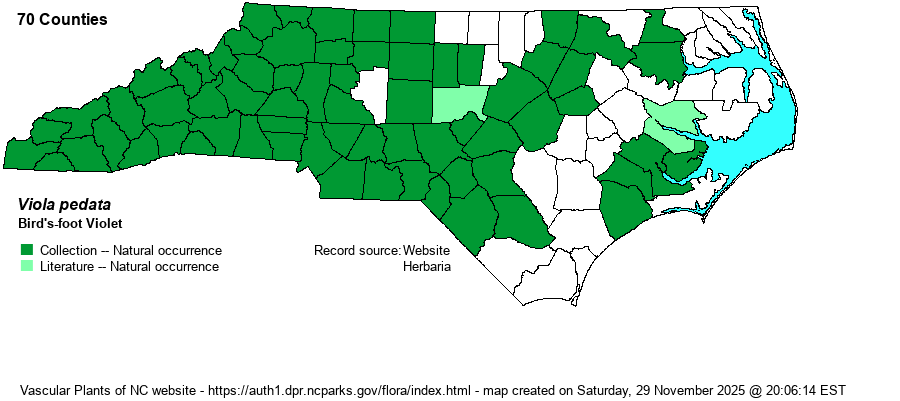| Author | L. | |
| Distribution | Throughout the Mountains and Piedmont; also across most of the upper Coastal Plain, but of scattered occurrence in the central and eastern part of the province, being absent in the far eastern counties. Ranges east to Hertford, Bertie, and Pamlico counties.
This is an Eastern and Midwestern species, with an odd range, being quite scarce in the Ohio River Valley area of western PA, OH, IN, and western WV. Otherwise, it ranges from NH west to ND, and south to southern GA and eastern TX. | |
| Abundance | Frequent to common in the Mountains and western Piedmont; fairly common in the southeastern Piedmont and common in the Sandhills region of the Coastal Plain. Uncommon to infrequent in the northeastern Piedmont and the western half of the Coastal Plain (outside the Sandhills), and very rare near the southern coast. | |
| Habitat | This is a violet of dry soils, usually in partial sun. It grows best on dry, often gravelly, roadbanks; but it also occurs around outcrops, in glades and barrens, and in sandy, open woods such as fire-managed Longleaf Pine uplands. |
| Phenology | Blooms from March to May, and fruits from May to June. | |
| Identification | This violet has the largest flower in the genus in our area, and thus is a favorite of wildflower enthsiasts. It has only basal leaves, but these are very distinctive, being dissected into 9-15 very narrow, linear segments; the leaves are on long petioles. The Sandhills variety (var. flabellata) has the leaves only partly cut, and are wedge-shaped or fan-shaped instead of deeply cut into narrow segments. The flowering stalks reach 6-8 inches tall, and the flower is usually 1.5 inches tall and nearly as wide. In some forms the upper two petals are a darker violet than the lower three, but in many the petals are all the same color -- a lavender to medium purple-violet in hue. The ends of the orange stamens protrude beyond the face of the flower, and the mouth of the flower is a contrasting white color. This species should not be confused with any other, though V. brittoniana also has highly dissected leaves and large violet-purple flowers. However, it grows in wet flats and other damp ground, and the stamens are hidden inside the flower opening. This is one of the few violet species that can be easily seen and identified from a moving vehicle, as many sizable stands grow along dry roadbanks. | |
| Taxonomic Comments | Several varieties are present in NC. The nominate one -- var. pedata -- is found across the range, but var. flabellata is limited to the Sandhills region.
General note on Viola: In 2009-10 B.A. Sorrie (website map editor) went through the whole collection at NCU, annotating all specimens against those verified by experts in the genus. The range maps in RAB (1968) have been changed accordingly. More recently, Harvey Ballard and colleagues are in the process of revising all Eastern and Southeastern Viola, and have annotated all specimens at NCU in July 2024. They recognize additional species not in RAB or in previous editions of Weakley et al.; we will follow updated editions of Weakley et al. in recognizing them. Species range maps have been adjusted to account for identification changes. | |
| Other Common Name(s) | Mountain Pansy | |
| State Rank | S4 [S5] | |
| Global Rank | G5 | |
| State Status | | |
| US Status | | |
| USACE-agcp | FACU link |
| USACE-emp | FACU link |

